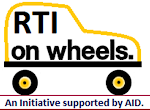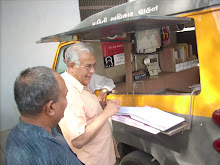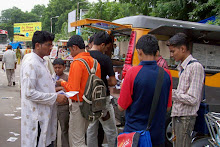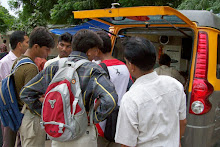Indian Express: Mumbai: Saturday,
October 01, 2016.
AT 11 am
everyday, a group of schoolchildren from a slum in Mhada Layout, Andheri, leave
home for the D N Nagar Municipal School, located roughly 3km away. First, they
cross a busy signal to try their luck at the BEST bus stop. Most days, they end
up walking a journey that takes at least 40 minutes.
Access to
school, a basic right of every child as per the Right to Education (RTE) Act,
is a challenge for the children in this slum, home to at least 850 families.
The Model Rules laid down by the RTE Act say that children in classes I-V
should have a school in a 1-kilometre neighbourhood, and the limit for those in
classes VI-VIII is three kilometres, even though the Act does not define the
limits or area of neighbourhood.
However, in
this slum, where most men do not have fixed incomes and the women work as
domestic helps in nearby housing societies, the nearest municipal school is at
D N Nagar. To ferry the children to school, a non-government organisation (NGO)
started a free bus service. But parents claimed the timings of the service were
irregular. “The bus picks up children from a nearby area but the timings are
uncertain, so we cannot depend on it,” said Anju Patil, whose son and daughter
attend school at D N Nagar.
However, the
bus service still remains a highly used mode of transport by students, a Right
to Information (RTI) response from the school has revealed. The RTI plea was
filed by activist Ghanshyam Sonar.
The other modes
of transport mentioned in the response were autorickshaws or private vehicles.
While the school said only a few walked all the way, parents and children have
a different story to tell. “Very few families can afford autorickshaws,” said
Parveen Bano Sheikh, a resident of the slum. “I pay Rs 600 a month for each of
my two children for the autorickshaw,” said Patil.
According to
the parents, dropping the children off in private vehicles is not feasible for
them for two reasons most families do not own vehicles and the parents do not
have time in the mornings as they have to go to work. As a result, the children
make their way to school on their own. “If we are lucky, we get a BEST bus.
Otherwise we walk,” said Omkar Chanwar (14) who is in Class VIII.
For Chanwar,
the distance will double next year when he is promoted to Class IX. Since the D
N Nagar Municipal School offers classes only upto Class VIII, Chanwar will have
to attend the night school at Goregaon.
The lack of
access to schools has led to many children, especially girls, dropping out.
Sheikh, whose daughter dropped out three years ago after completing Class VII,
said parents were not comfortable sending their children too far.
This is a
gross violation of the RTE Act by the Brihanmumbai Municipal Corporation (BMC),
said Sonar. He said the BMC was responsible for providing proper access to the
school or opening another school closer to the slum.
Following
requests by parents and activists, the civic body is now considering a free bus
service for the children. The bus will ferry children to and from the slum for
both morning and afternoon shifts.
“We plan to
start a BEST bus service this week for the students,” said BMC Education
Officer Mahesh Palkar. He said the BMC will also check if the school complex
has enough infrastructure to start senior classes.














































































